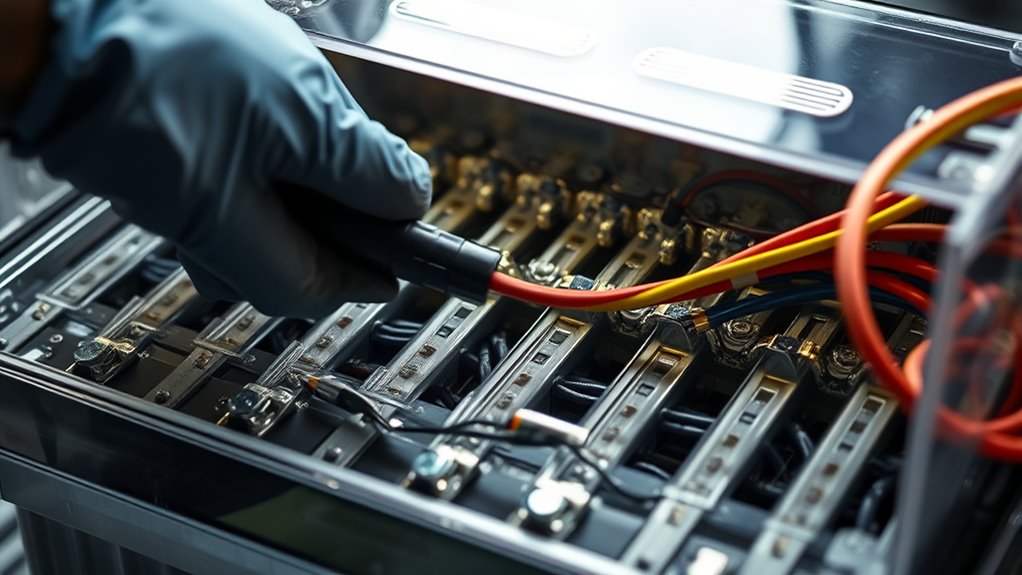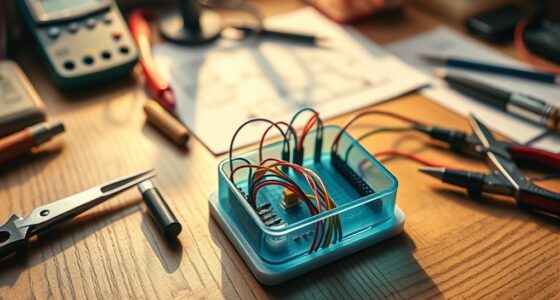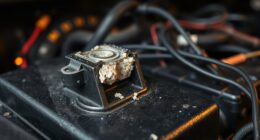Equalization charging restores the full capacity of your lead-acid batteries by balancing cell voltages and preventing uneven wear. During this process, you increase the charging voltage beyond normal levels to break down sulfate crystals and equalize electrolyte levels. Proper regulation of voltage and monitoring of temperature are key to avoid damage. Continuing below reveals how this essential procedure extends battery life and keeps your system running smoothly.
Key Takeaways
- Equalization charging balances individual cell voltages, preventing sulfation and uneven degradation to restore battery capacity.
- It involves applying a higher voltage (2.55–2.6V per cell) for several hours to break down sulfate crystals.
- Proper voltage regulation ensures safe charging, avoiding overcharging and electrolyte loss during the process.
- After equalization, voltage is reduced to maintenance levels to prevent damage and electrolyte stratification.
- Regular equalization extends battery lifespan, improves performance, and maintains maximum capacity.

Equalization charging is a essential process for maintaining the health and performance of lead-acid batteries. When you perform this procedure, you’re fundamentally balancing the cells within the battery to guarantee each one reaches an ideal level of charge. Without regular equalization, your battery can develop issues like sulfation and uneven cell degradation, which reduce capacity and shorten its lifespan. This makes proper battery maintenance necessary for keeping your system reliable and efficient. One key aspect of effective maintenance involves managing voltage regulation during the equalization process. By carefully controlling the voltage applied to your batteries, you can prevent overcharging or undercharging, both of which can cause damage. Proper voltage regulation ensures that each cell receives the right amount of charge, promoting uniformity across the entire battery bank. When you initiate equalization, you typically increase the charging voltage beyond the standard float or cycle levels, usually to around 2.55 to 2.6 volts per cell for a flooded lead-acid battery. This higher voltage helps break down sulfate crystals that form on the plates, restoring capacity. However, it’s fundamentally important to monitor the process closely, as excessive voltage can lead to water loss and overheating. During equalization, you should keep a close eye on the battery’s temperature and electrolyte levels. Maintaining proper voltage regulation helps prevent excessive gassing, which can be dangerous and lead to electrolyte evaporation. If your charger offers adjustable voltage settings, use these to fine-tune the process, ensuring you’re applying enough voltage to equalize without causing harm. You’ll want to run the equalization until the specific gravity readings of the electrolyte are balanced across all cells, indicating uniform charge levels. This process typically lasts several hours, depending on the battery size and condition. Once complete, you should reduce the voltage back to the recommended maintenance level for your battery type. Regularly performing equalization charging as part of your battery maintenance routine can greatly extend your battery’s lifespan and improve its overall performance. It also helps prevent issues like stratification, where the electrolyte becomes uneven, and reduces the risk of premature failure. Remember, a well-regulated equalization process not only restores capacity but also preserves the integrity of your lead-acid batteries, ensuring they remain reliable in demanding applications. Staying vigilant during this process, particularly with voltage regulation, makes all the difference in maintaining a healthy, long-lasting battery system. Additionally, understanding keto-friendly ingredients can be beneficial if you’re looking to incorporate low-carb dietary options into your routine, which can support overall health and energy levels necessary for maintaining such equipment.
Frequently Asked Questions
How Often Should Equalization Charging Be Performed?
You should perform equalization charging every 30 to 60 days, depending on your usage and battery condition. Regular battery maintenance helps guarantee peak performance by voltage balancing the cells. Keep an eye on your battery’s specific gravity and voltage levels, and if you notice uneven readings, it’s time for an equalization charge. This process restores capacity and prolongs your battery’s life.
Can Equalization Damage a Lead-Acid Battery?
Think of equalization as fine-tuning a musical instrument; done right, it improves performance, but too much or too often can cause damage. Equalization can harm a lead-acid battery if misapplied or overdone, leading to overheating or grid damage. Proper battery maintenance and correct charging techniques guarantee you avoid these risks, extending your battery’s lifespan. Always follow manufacturer guidelines to prevent accidental damage during equalization.
What Are Signs Indicating the Need for Equalization?
You should consider equalization if you notice voltage imbalance between your batteries or sulfation buildup on the plates. These signs indicate that your batteries aren’t charging evenly or are developing deposits that reduce capacity. When these issues occur, equalization helps restore balance and remove sulfation. Keep an eye on voltage readings and battery performance, and don’t delay equalization, as neglecting these signs can lead to reduced battery lifespan and efficiency.
Is Equalization Necessary for Sealed AGM Batteries?
Yes, equalization is necessary for sealed AGM batteries to guarantee proper battery maintenance and voltage balancing. Although sealed AGM batteries are designed to be low-maintenance, over time, they can develop uneven charge levels. Performing an equalization charge helps restore capacity by balancing voltages across cells, preventing sulfation, and extending battery life. Just make sure to follow manufacturer guidelines to avoid overcharging or damaging your sealed AGM batteries during this process.
How Long Does an Equalization Cycle Typically Last?
An equalization cycle usually lasts between 4 to 8 hours, depending on your battery’s capacity and condition. During this process, you’ll apply a higher voltage to correct voltage imbalances and effectively remove sulfate buildup. Monitoring the temperature and voltage helps prevent overcharging. This cycle restores capacity by balancing cells, ensuring peak performance, and prolonging your battery’s lifespan. Always follow manufacturer guidelines for precise timing and safety measures.
Conclusion
By performing equalization charging, you guarantee your lead-acid batteries regain their full capacity and longevity, much like restoring a trusty steed for another journey. Don’t forget, neglecting this step can lead to diminished performance and premature failure. Treat your batteries like a cherished relic—care for them wisely, and they’ll serve you faithfully for years to come. Remember, even in this modern age, a well-maintained battery remains the backbone of your power needs.










